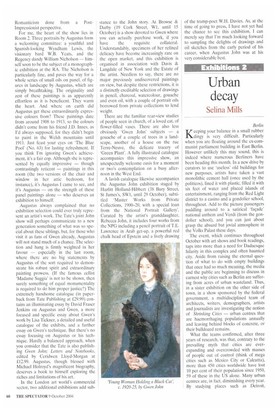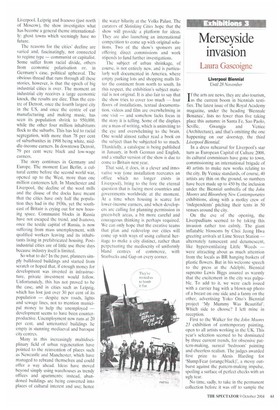Urban decay
Selina Mills
Berlin Keeping your balance in a small rubber dingy is very difficult. Particularly when you are floating around the ex-communist parliament building in East Berlin. However unlikely this may sound, this is indeed where numerous Berliners have been heading this month. In a new drive by curators to use 'useless' old buildings for new purposes, artists have taken a vast monolithic cement hall (once used by the politicos), lined it with plastic, filled it with six feet of water and placed islands of entertainment, ranging from the Red Light district to a casino and a gondolier school, throughout. Add to the picture passengers paddling around to a satirical 'facade' national anthem and Verdi (from the gondolier school), and you can just about grasp the absurd but jovial atmosphere in the Volks Palast these days.
The event, which continues throughout October with art shows and book readings, taps into more than a need for Dadaesque hilarity in this complex and often haunted city. Aside from raising the eternal question of what to do with empty buildings that once had so much meaning, the media and the public are beginning to discuss in earnest why cities such as Berlin are suffering from acres of urban wasteland. Thus, in a sister exhibition on the other side of town, in a show sponsored by the federal government, a multidisciplined team of architects, writers, demographers, artists and journalists are investigating the notion of Shrinking Cities — urban centres that are haemorrhaging populations annually and leaving behind blocks of concrete, or their bulldozed remains.
What the teams confirmed, after three years of research, was that, contrary to the prevailing myth that cities are everexpanding and overcrowded with masses of people out of control (think of mega cities such as Mexico City or Calcutta), more than 450 cities worldwide have lost 10 per cent of their population since 1950, 59 of these in the US alone. Many urban centres are, in fact, diminishing every year. By studying places such as Detroit, Liverpool, Leipzig and Ivanovo (just north of Moscow), the show investigates what has become a general theme internationally: ghost towns which seemingly have no future.
The reasons for the cities' decline are varied and, fascinatingly, not connected to regime type — communist or capitalist. Some suffer from racial divide, others from economic polarisation or, in Germany's case, political upheaval. The obvious thread that runs through all these stories, however, is that the epoch of big industrial cities is over. The moment an industrial city receives a large economic knock, the results are dire. Thus the centre of Detroit, once the fourth largest city in the US, and once the centre of car manufacturing and making music, has seen its population shrink to 950,000, while the other four million inhabitants flock to the suburbs. This has led to racial segregation, with more than 78 per cent of suburbanites in 1998 being white, middle-income earners. In downtown Detroit, 79 per cent were black and low-wage earners.
The story continues in Germany and Europe. The moment East Berlin, a cultural centre before the second world war, opened up to the West, more than one million easterners left. In Manchester and Liverpool, the decline of the wool mills and the disuse of the docks have meant that the cities have only half the population they had in the 1930s, yet the southeast of Britain is crying out for new housing space. Communist blocks in Russia have not escaped the trend, and lvanovo, once the textile capital of Russia, is now suffering from mass unemployment, with qualified workers leaving and its inhabitants living in prefabricated housing. Postindustrial cities are of little use these days because industry itself is limited.
So what to do? In the past, planners simply bulldozed buildings and started from scratch or hoped that, if enough money for development was invested in infrastructure, private investment would follow. Unfortunately, this has not proved to be the case, and in cities such as Leipzig, which has lost just over 30 per cent of its population — despite new roads, lights and sewage lines, not to mention municipal money to help the unemployed — development seems to have been counterproductive. Unemployment now runs at 20 per cent, and untenanted buildings lie empty in stunning mediaeval and baroque City centres.
Many in this increasingly multidisciplinary field of urban regeneration have pointed to the reinvention of places such as Newcastle and Manchester, which have managed to rebrand themselves and could offer a way ahead. Ideas have moved beyond simply using warehouses as trendy offices and apartments; instead, abandoned buildings are being converted into places of cultural interest and use; hence the water hilarity at the Volks Palast. The curators of Shrinking Cities hope that the show will provide a platform for ideas. They are also launching an international competition to come up with original solutions. Two of the show's sponsors are offering direct commissions and work stipends to fund further investigations.
The subject of urban shrinkage, of course, is not entirely new, and is particularly well documented in America, where empty parking lots and shopping malls litter the continent from north to south. In this respect, the exhibition's subject material is not original. It is also fair to say that the show tries to cover too much — four floors of installations, textual documentation, videos and film are overwhelming in one visit — and somehow lacks focus in the story it is telling. Some of the displays are a mass of writing, which is uninviting to the eye and overwhelming to the brain. One would almost rather read a book on the subject than be subjected to so much. Thankfully, a catalogue is being published in January, in both German and English, and a smaller version of the show is due to come to Britain next year.
That said, it does, in a clever and innovative way (one installation recreates an office which no longer exists in Liverpool), bring to the fore the eternal question that is facing most countries and governments worldwide at the moment. At a time when housing is scarce for lower-income earners, and when developers are calling for planning permission in green-belt areas, a bit more careful and courageous thinking is perhaps required. We can only hope that the creative teams that plan and redevelop our cities will come up with ways of using cultural heritage to make a city distinct, rather than perpetuating the mediocrity of uniformly bland centres of commerce, with Starbucks and Gap on every corner.



















































































































 Previous page
Previous page